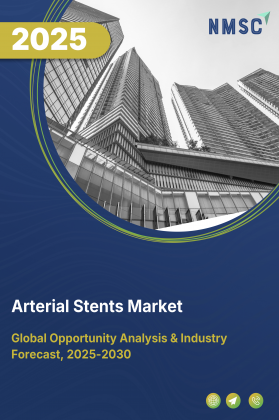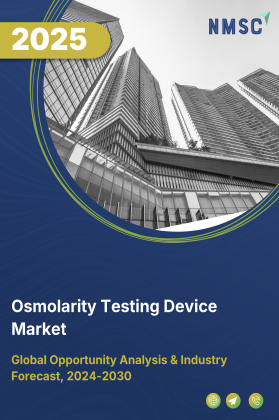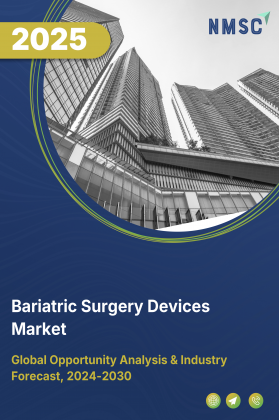
Arterial Stents Market by Material (Metal Alloys and Polymer), by Product Type (Coronary Stents and Peripheral Stents), by Procedure Type (Percutaneous Coronary Intervention, Peripheral Artery Intervention and Others), by Application (Coronary Artery, Carotid Artery, Iliac Artery and Others), and by End-Users (Hospitals, Cardiac Catheterization Laboratories and Others) – Global Opportunity Analysis and Industry Forecast 2025–2030
Arterial Stents Industry Outlook
The global Arterial Stents Market size was valued at USD 16.18 billion in 2024, with an estimation of USD 17.93 billion in 2025 and is predicted to reach USD 29.94 billion by 2030 with a CAGR of 10.8% from 2025-2030.
The market is witnessing steady growth, driven by the rising prevalence of cardiovascular diseases and the increasing preference for minimally invasive procedures to restore blood flow and prevent life-threatening complications. Advancements in stent technology, such as drug-eluting and bioresorbable stents, are enhancing patient outcomes by reducing risks of restenosis and improving recovery times.
The arterial stents market growth is further supported by a growing elderly population that is more vulnerable to chronic cardiovascular conditions, along with expanding healthcare infrastructure and greater investment in advanced medical devices. Collectively, these factors are shaping a competitive landscape where innovation, accessibility, and clinical effectiveness remain central to long-term industry expansion.
Rising Cardiovascular Deaths Boosting Arterial Stent Demand
Cardiovascular diseases continue to be the leading cause of mortality worldwide, creating a critical demand for arterial stents as life-saving interventions. Every year, CVD claims over 20.5 million lives globally, according to the World Heart Federation. Factors such as sedentary lifestyles, unhealthy dietary habits, stress, and rising cases of hypertension and diabetes are further contributing to the increase in cardiovascular fatalities.
As a result, the demand for minimally invasive procedures like stenting has surged, as these interventions help restore blood flow, prevent severe complications like heart attacks, and improve patient survival rates. The rising mortality burden emphasizes the urgent need for advanced stenting solutions that offer better outcomes, fewer complications, and faster recovery times.
Growing Aging Population Accelerating Market Growth
The global aging population is another major factor driving the arterial stents market demand. Elderly individuals are more susceptible to chronic illnesses, especially cardiovascular conditions such as coronary artery disease, which require stenting interventions to maintain proper blood circulation.
As per the United Nations World Population Prospects 2022, the population aged 65 years and above accounted for 10% of the global population in 2022 and is expected to rise to 16% by 2050. This demographic shift will significantly strain healthcare systems, increasing the need for advanced cardiovascular treatments, including drug-eluting and bioresorbable stents, to cater to the growing patient base. Additionally, longer life expectancies and the preference for minimally invasive solutions among older adults further amplify the demand for innovative arterial stenting procedures.
Rising Healthcare Expenditure Supporting Advanced Medical Interventions
The consistent rise in global healthcare expenditure provides a strong foundation for adopting cutting-edge medical technologies, including arterial stents. Governments and healthcare organizations are allocating greater budgets toward cardiovascular care infrastructure, enabling access to modern treatment options. For instance, the Centers for Medicare & Medicaid Services reported that U.S. national health spending grew by 8.2% in 2024 and is projected to increase by 7.1% in 2025, reflecting the continued prioritization of life-saving medical solutions.
Similarly, global health expenditure as a share of GDP has steadily increased over the past decade, highlighting a growing commitment to improving healthcare outcomes. This financial growth facilitates the procurement of advanced stent technologies, training for healthcare professionals, and the expansion of cardiovascular care facilities, collectively boosting the arterial stents market expansion.
Risks Associated with Stent Procedures Restrain the Market Growth
Despite the growing demand for arterial stents, certain risks limit their widespread adoption. Procedures involving stent placement carry the possibility of restenosis, thrombosis, and in some cases, post-surgical infections. These complications lead to repeat procedures, higher medical costs, and concerns among patients and healthcare providers.
Additionally, long-term reliance on traditional metallic stents poses challenges, such as chronic inflammation or delayed healing, further restraining market growth. The need for frequent follow-ups and potential for secondary interventions discourages patients from opting for stenting solutions, especially in regions with limited healthcare infrastructure.
Introduction of Bioresorbable Stents Creates Future Growth Opportunities
The advent of bioresorbable stents marks a transformative shift in cardiovascular treatment, opening promising avenues for market growth. Unlike traditional metallic stents that remain permanently implanted, bioresorbable stents are designed to gradually dissolve within the body after restoring normal blood flow, leaving behind a naturally healed vessel. This innovation addresses several long-standing challenges associated with conventional stents, such as late-stage thrombosis, chronic inflammation, and the need for long-term dual antiplatelet therapy.
With increasing demand for minimally invasive and patient-friendly treatment solutions, the introduction of bioresorbable technologies is expected to redefine the arterial stent landscape, offering safer outcomes, reduced post-procedure complications, and improved quality of life.
The recent FDA approval of Abbott’s Esprit BTK Everolimus Eluting Resorbable Scaffold System in April 2024 further underscores the potential of these next-generation stents to become a key growth driver for the global arterial stents market in the coming years.
Market Segmentations and Scope of the Study
The arterial stents market report is segmented on the basis of material, product type, procedure type, application, and end-users. On the basis of material, the market is divided into metal alloys and polymer. On the basis of product type, the market is categorized into coronary stents and peripheral stents. On the basis of procedure type, the market covers percutaneous coronary intervention, peripheral artery intervention, and carotid artery intervention. Based on application, the market is segmented into coronary artery, carotid artery, iliac artery, femoral & popliteal artery, and others. On the basis of end-users, the market is classified into hospitals, cardiac catheterization laboratories, ambulatory surgical centers, and specialized clinics. The regional breakdown includes regions such as North America, Europe, Asia-Pacific, and the Rest of the World (RoW).
Geographical Analysis
North America dominates the arterial stents market share and is expected to maintain its leadership throughout the forecast period. This dominance is primarily driven by rising healthcare spending in countries like the U.S. and Canada, which supports the adoption of advanced cardiovascular treatment solutions. The surge in funding allows hospitals and healthcare providers to integrate cutting-edge stenting technologies, improve patient access to minimally invasive procedures, and enhance overall treatment outcomes for cardiovascular patients.
Europe is witnessing steady growth in the market, primarily due to its rapidly aging population and increasing prevalence of cardiovascular diseases. Projections from the European Commission indicate that the EU population is projected to increase from 446.7 million in 2022 and peak at 453.3 million in 2026, further contributing to the demand for advanced healthcare solutions. Moreover, favorable government policies, along with well-established healthcare systems in countries like Germany, France, and the U.K., are further driving the region's market growth.
The Asia-Pacific region is expected to witness the fastest growth in the arterial stents market trends, primarily driven by its rapidly aging population and the rising prevalence of cardiovascular diseases. According to the World Health Organization (WHO), China has one of the fastest-growing aging populations globally, with individuals aged 60 years and above projected to account for 28% of the population by 2040. This shift is largely attributed to longer life expectancy and declining fertility rates.
Likewise, countries such as Japan, India, and South Korea are experiencing a surge in coronary artery disease cases, pushing healthcare providers to adopt advanced medical technologies, including bioresorbable and drug-eluting stents. Furthermore, ongoing investments in healthcare infrastructure, supportive government programs for chronic disease management, and increasing awareness about minimally invasive cardiovascular treatments are expected to accelerate market expansion across the region.
The Rest of the World (RoW), including Latin America, the Middle East, and Africa, presents emerging opportunities for the market. Rising healthcare investments, coupled with increasing awareness about cardiovascular diseases, are fueling demand for advanced treatment options in these regions.
Countries like Brazil, South Africa, and the UAE are witnessing expanding healthcare facilities and growing partnerships with medical device manufacturers to improve access to life-saving interventions such as arterial stenting. Although healthcare infrastructure in several parts of Africa remains underdeveloped, ongoing government initiatives and international funding for cardiovascular care are expected to create favorable growth prospects over the coming years.
Strategic Innovations Adopted by Key Players
Key players in the arterial stents industry are accelerating global expansion through upscale brand launches, service diversification, and strategic partnerships.
-
In May 2025, Terumo Interventional Systems, a division of Terumo Corporation, has announced the early commercial availability of its FDA-approved ROADSAVER™ Carotid Stent System. Designed for use with the Nanoparasol Embolic Protection System, the ROADSAVER Stent System targets carotid artery stenosis in patients at high risk of adverse events following carotid endarterectomy. This launch highlights Terumo’s focus on expanding its arterial stent portfolio, particularly in the carotid segment, and strengthens its competitive positioning in the global market.
-
In July 2024, MicroPort Scientific Corporation announced that its wholly-owned subsidiary, Shanghai MicroPort Medical Co., Ltd has received market approval from China’s National Medical Products Administration for Firesorb, the world’s first next-generation fully bioresorbable cardiac stent. This milestone underscores MicroPort’s commitment to innovation in arterial stents, particularly in the coronary segment, and strengthens its competitive position in the rapidly growing global market.
Key Benefits
-
The report provides quantitative analysis and estimations of the industry from 2025 to 2030, which assists in identifying the prevailing arterial stents market opportunities.
-
The study comprises a deep-dive analysis of the current and future arterial stents market trends to depict prevalent investment pockets in the sector.
-
Information related to key drivers, restraints, and opportunities and their impact on the market is provided in the report.
-
Competitive analysis of the players, along with their market share is provided in the report.
-
SWOT analysis and Porters Five Forces model is elaborated in the arterial stents market study.
-
Value chain analysis in the market study provides a clear picture of roles of stakeholders.
Arterial Stents Market Key Segments
By Material
-
Metal Alloys
-
Polymer
By Product Type
-
Coronary Stents
-
Bare Metal Stents
-
Drug-eluting Stents
-
Bioreabsorbable Stents
-
Others
-
-
Peripheral Stents
-
Self-Expandable Stents
-
Balloon-Expanding Stents
-
Others
-
By Procedure Type
-
Percutaneous Coronary Intervention
-
Peripheral Artery Intervention
-
Carotid Artery Intervention
By Application
-
Coronary Artery
-
Carotid Artery
-
Iliac Artery
-
Femoral & Popliteal Artery
-
Others
By End-Users
-
Hospitals
-
Cardiac Catheterization Laboratories
-
Ambulatory Surgical Centers
-
Specialized Clinics
By Region
-
North America
-
The U.S.
-
Canada
-
Mexico
-
-
Europe
-
The UK
-
Germany
-
France
-
Italy
-
Spain
-
Denmark
-
Netherlands
-
Finland
-
Sweden
-
Norway
-
Russia
-
Rest of Europe
-
-
Asia-Pacific
-
China
-
Japan
-
India
-
South Korea
-
Australia
-
Indonesia
-
Singapore
-
Taiwan
-
Thailand
-
Rest of Asia-Pacific
-
-
RoW
-
Latin America
-
Middle East
-
Africa
-
Key Players
-
Terumo Corporation
-
Abbott Laboratories
-
Acandis
-
MicroPort Scientific
-
Cardinal Health
-
B. Braun SE
-
Optimed Medizinische Instrumente
-
L. Gore and Associates
-
Medtronic
-
Biotronik
-
Lepu Medical Technology Co., Ltd
-
Meril Life Sciences Pvt. Ltd
-
Invamed
Report Scope and Segmentation
|
Parameters |
Details |
|
Market Size in 2025 |
USD 17.93 Billion |
|
Revenue Forecast in 2030 |
USD 29.94 Billion |
|
Growth Rate |
CAGR of 10.8% from 2025 to 2030 |
|
Analysis Period |
2024–2030 |
|
Base Year Considered |
2024 |
|
Forecast Period |
2025–2030 |
|
Market Size Estimation |
Million (USD) |
|
Growth Factors |
|
|
Countries Covered |
28 |
|
Companies Profiled |
15 |
|
Market Share |
Available for 10 companies |
|
Customization Scope |
Free customization (equivalent up to 80 working hours of analysts) after purchase. Addition or alteration to country, regional, and segment scope. |
|
Pricing and Purchase Options |
Avail customized purchase options to meet your exact research needs. |

















 Speak to Our Analyst
Speak to Our Analyst

























